It would be inaccurate to assert that photography created suburbia. The camera no more built the suburbs than it constructed the Eiffel Tower or the Empire State Building. Yet today, photographers like Brian Ulrich are making images that can heighten our understanding of the congested, much-derided landscape between “city” and “country.”
Ulrich, who teaches photography at RISD, began his Copia project in 2001 as an exploration of the American retail landscape. The vast majority of Ulrich’s documentary work was done in the suburbs: at strip malls, in parking lots, at the threshold of a local IKEA. A decade or more after Ulrich began his project, these liminal areas still hold the key to understanding the design landscape of American commerce: despite the growing presence of online sales, more than 90 percent of American retail sales still occur in a traditional bricks and mortar environment.
The Copia project surveys that environment, including not only photographs, but also the detritus of suburban expansion, like forgotten blue prints. In assembling a picture of twentieth-century American retail and its ephemera, Ulrich presents a new way of thinking about suburbs. Rather than being seen as a tired landscape of commuter-belt housing, the suburbs emerge as something new: a place where Americans continually navigate new relationship with consumer goods and the material world.
In Ulrich’s photos of the crowded store aisles and abandoned shopping, it seems possible to grade the character of suburbia by the nature and density of consumer goods for sale. Ulrich’s America is a place where variety is produced by moving up and down the socio-economic retail ladder, rather than traveling from one geographic region to another. Suburbia, it becomes clear, is a product of land prices and consumer purchasing power, a netherworld where the surrounding population is dense and mobile enough to shop, but where commercial leases remain inexpensive enough for retailers to profitably display and process merchandise on a massive scale.
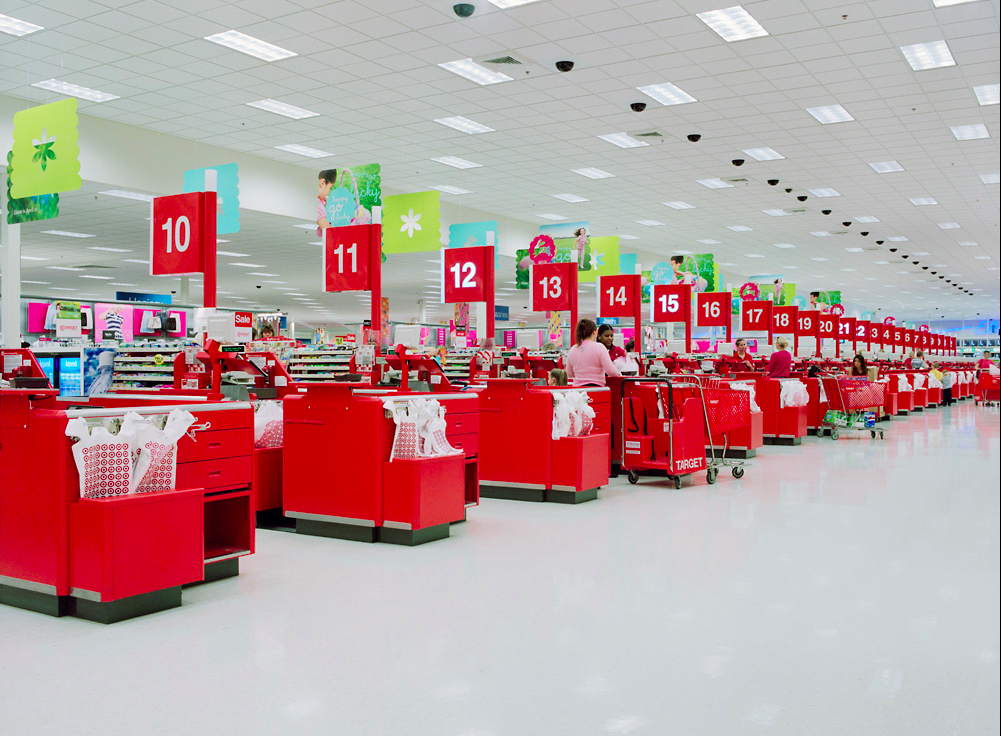
Granger, Indiana, 2003
Ulrich, who teaches photography at RISD, began his Copia project in 2001 as an exploration of the American retail landscape. The vast majority of Ulrich’s documentary work was done in the suburbs: at strip malls, in parking lots, at the threshold of a local IKEA. A decade or more after Ulrich began his project, these liminal areas still hold the key to understanding the design landscape of American commerce: despite the growing presence of online sales, more than 90 percent of American retail sales still occur in a traditional bricks and mortar environment.
The Copia project surveys that environment, including not only photographs, but also the detritus of suburban expansion, like forgotten blue prints. In assembling a picture of twentieth-century American retail and its ephemera, Ulrich presents a new way of thinking about suburbs. Rather than being seen as a tired landscape of commuter-belt housing, the suburbs emerge as something new: a place where Americans continually navigate new relationship with consumer goods and the material world.
In Ulrich’s photos of the crowded store aisles and abandoned shopping, it seems possible to grade the character of suburbia by the nature and density of consumer goods for sale. Ulrich’s America is a place where variety is produced by moving up and down the socio-economic retail ladder, rather than traveling from one geographic region to another. Suburbia, it becomes clear, is a product of land prices and consumer purchasing power, a netherworld where the surrounding population is dense and mobile enough to shop, but where commercial leases remain inexpensive enough for retailers to profitably display and process merchandise on a massive scale.

Granger, Indiana, 2003
Ulrich begins his investigation in the space of big box retailers like Target. Granger, Indiana, is drawn from the Retail section of Copia. (The other sections are Thrift, Great Prosperity, Dark Stores, and Relics). In Granger, Ulrich presents an interior as expansive and rectilinear as the fields of the American Midwest. The Target store is a place where fluorescent lights rather than clouds float across a wide open sky; where the dominant colors are a patriotic combination of red, white and blue. (The town, ironically, was named for the nineteenth-century pro-agriculture Granger movement). It is easy for American viewers to dismiss this familiar corporate interior. But Ulrich performs the necessary trick of making the familiar strange. Looking carefully at this image—which Ulrich has staged looking back at the registers with something like an objective version of buyer’s remorse—a viewer might realize how little she knows about Target’s design or floorplan. Is it deliberate that the blue neon on the rear wall mimics a hint of sky at a natural horizon? Have we become accustomed to reading the season and the holiday only from seasonal banners above cash registers? Many viewers would swear that all Target outlets look more or less alike, and Ulrich found less variation than he hoped as he traveled the country. For many, Granger will make it clear how uncritically shoppers use their landscape. Only a few will notice, for instance, whether the camera oculi on the ceiling are in the same formation as their local Target, or whether Target’s surveillance has increased or decreased in the past decade.
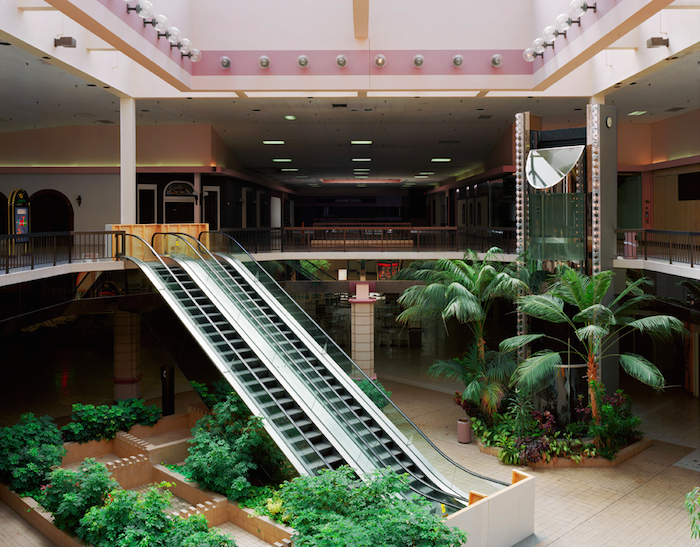
Rolling Acres Mall
In its ideal form, suburbia is supposed to present a harmonious balance of the natural and the manmade: a place where a heteronormative couple might raise children in bucolic surroundings. Yet this vision proved difficult to build. The manmade all too often overran the natural. Developers’ greed all too frequently overran utopian dreams of generous open spaces. The generically named Rolling Acres Mall, located on the outskirts of Akron, Ohio, was shuttered in 2008, shortly before Ulrich captured this image. Like a Victorian deathbed photograph, Ulrich’s image captures the stillness of the mall’s metaphorical skin and bones after the life force has left the building. Nature looks ready to take its course, the semi-tropical plants ignorant of any Midwestern gale which may have been raging outside Rolling Acres’ dated interior world of fairground lights and glass-capsule elevators.
 Opening ceremonies ar Goldblatt's store, Markham, Illinois, 1960
Opening ceremonies ar Goldblatt's store, Markham, Illinois, 1960As the Copia project progressed, Ulrich began gathering an archive of cheaply acquired ephemera: publicity photos, dated correspondence, and even surveillance material like the Polaroid portraits of suspected shoplifters many department stores post in their employee workrooms. Ulrich began to make art out of this ephemera. The reprinted Goldblatt’s image—the negative number is still visible in the upper left of the image—is as much a comment on the role of photography in expanding and defining the suburban experience as it is a document of the postwar architecture of shopping. These images show how publicity photographs helped grow the suburbs and their culture. Ulrich also shows us a darker side: as budgets expanded in suburban police forces, local police department shot their own footage of crime scenes. Ulrich’s trove includes staged images of stolen goods being “discovered” by suburban police forces.
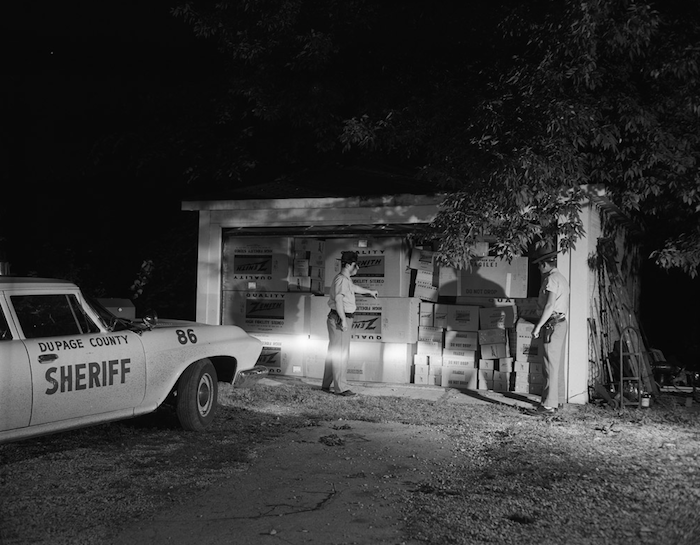
Boosted by publication in local newspaper, images of police lights shining on stacks of televisions hidden in garages or behind hay bales gave a clear message about the regulation of merchandise on the suburban frontier.

Untitled, 2007
Suburban goods, like suburban houses, are not always new. Ulrich used the Thrift section of Copia to explore the afterlife of consumer goods in the suburbs. In an interview with Design Observer, Ulrich compared thrift store employees with museum curators; the only difference, he noted, was the price and quality of the goods they handle. It is in Ulrich’s thrift store images that his human subjects seem most overpowered by the goods around them, most enclosed by narrow aisles and haphazard, teetering displays of merchandise. It is clear that the urge—as well as the legitimate need—to consume is not limited to the new. The edge of the city is where the manmade presses in on the nature and culture of human interaction. Old or new, Ulrich presents the landscape and culture of suburbia as being a vital place defined by a particular density of goods and transactions rather than simply a place at the end of the commuter line.
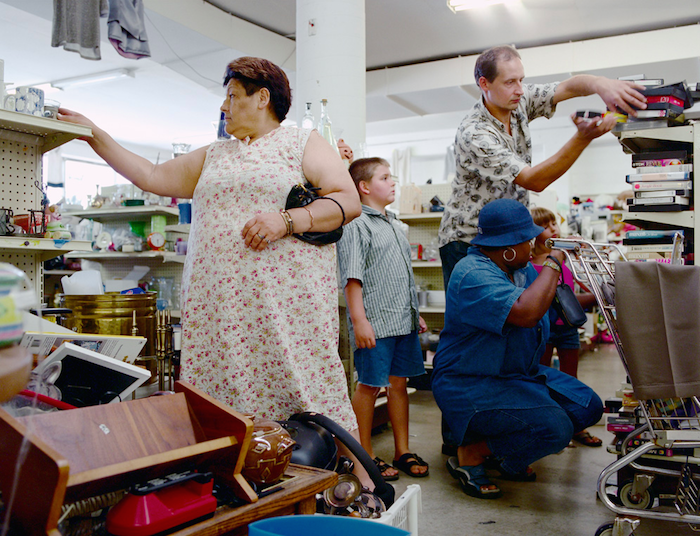
Untitled, 2005
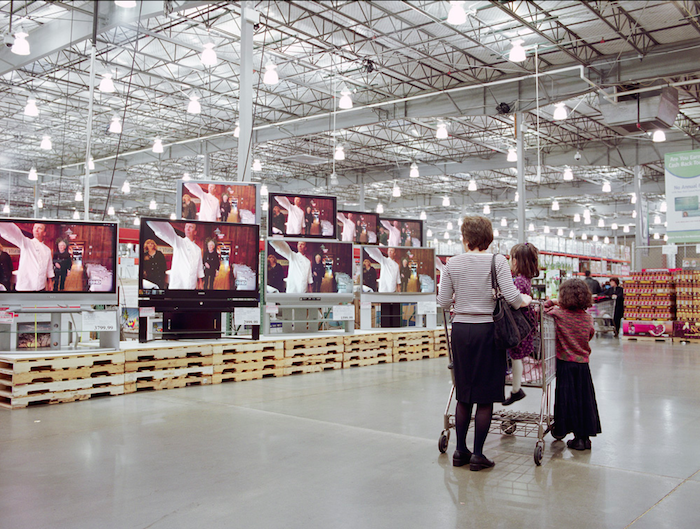
Chicago Illinois, 2006
